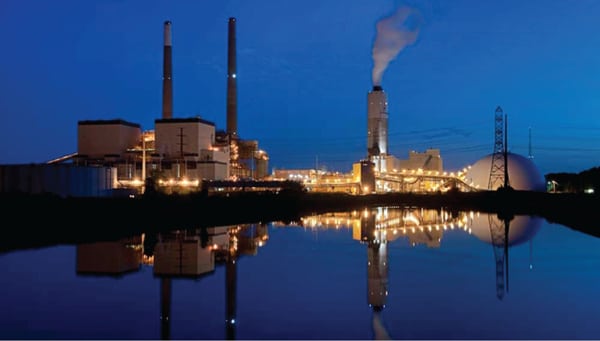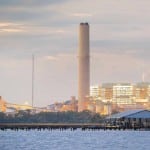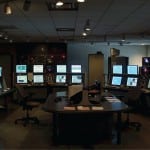Constellation Energy Constellation Energy recently completed a series of air quality upgrades on both units at its Brandon Shores Generating Station that included flue gas desulfurization (FGD), baghouse, SO3 control, and mercury reduction by activated carbon injection. The plant’s unique arrangement required long duct runs to the air quality system and a mile-long conveyor for moving barge-delivered limestone to the plant. Treated municipal wastewater was used as wet FGD supply water, and effluent treatment included first-of-its-kind nitrogen removal before discharge to the Chesapeake Bay watershed.
Constellation Energy can trace its roots back to 1816 when the Baltimore City Council approved plans for the nation’s first gas utility to light the city streets. The Gas Light Co. of Baltimore, after a series of consolidations and acquisitions, evolved into Baltimore Gas & Electric, the regulated side of Constellation Energy (CE). CE’s unregulated Power Generation Group owns about 8,900 MW of fossil and renewable generation assets consisting of 27 facilities located in six states and Canada.
Stringent Air Quality Rules
In 2006, the Maryland General Assembly adopted legislation (the Maryland Healthy Air Act, “MHAA”) requiring significant SO2, NOx, and mercury emission reductions from Maryland’s coal-fired units. Although it requires more stringent and earlier emission reductions, the MHAA generally correlates with emission reductions required by the Environmental Protection Agency’s Clean Air Interstate Rule and Clean Air Mercury Rule. According to the Maryland Department of the Environment (MDE), greater and earlier SO2 and NOx reductions and year-round controls were required to meet federal ambient air quality standards for fine particulate matter and ozone, and facility-specific mercury reductions were necessary for greater public health protection.
The MDE projects that its two-step reductions will ultimately achieve reductions of 75% of NOx by 2012, 85% of SO2 by 2013, and 90% of mercury by 2013, all compared to a 2002 baseline. The MHAA also prohibits Maryland power plants from using out-of-state emissions allowances to avoid achieving in-state emission reductions.
In Maryland, CE’s assets include nine power plants, including its largest coal-fired plant: the 1,273-MW Brandon Shores Generating Station (BSGS, Figure 1). BSGS, located on 375 acres along the western shore of the Patapsco River, 10 miles southeast of Baltimore, has two nominal 680-MW coal-fired units that started commercial operation in 1984 and 1991. To comply with the MHAA, CE budgeted $885 million to add the necessary air quality control system equipment to accommodate the combustion of coal containing up to 4% sulfur. The plant’s eastern bituminous coal supply is predominantly Central Appalachian, but the plant also burns Northern Appalachian coal and a variety of foreign coals when the market conditions are right. Coal is received by barge, which is unloaded and transferred by a mile-long conveyor to onsite coal storage piles.
 |
| 1. Built to last. Located on the shores of the Patapsco River on a 375-acre site 10 miles south of Baltimore, the Brandon Shores Generating Station has two generating units with a net capacity of 1,273 MW. A suite of new air quality control systems and 400-foot chimney (right) were installed on Brandon Shores Units 1 and 2 (left). The gypsum stackout in the gypsum storage dome is on the far right. The barge unloading station is about a mile to the right. Courtesy: Constellation Energy and HDR/CB |
Each of the natural circulation, balanced draft boilers was originally supplied by Babcock & Wilcox and included a hot-side electrostatic precipitator (ESP), first-generation low-NOx burners with overfire air, and selective catalytic reduction for NOx reduction. The original steam turbine was a General Electric tandem compound, double-flow reheat with two double-flow low-pressure turbines. Steam conditions are a standard 2,400 psig at 1,000F/1,000F. Emerson Ovation controls both units and the new air quality control systems (AQCS).
AQCS Upgrades
On March 1, 2010, CE announced completion of the Brandon Shores AQCS project, which brings both units into MHAA compliance well within the required deadlines (Unit 1 was completed in December 2009). Perhaps the most distinctive design requirement was for the AQCS to treat flue gases from coal that has a sulfur content ranging from 0.4% to 4.0%.
The AQCS additions begin with injecting hydrated lime for SO3 control at a nominal rate of 0.022 lb/million Btu of fuel input and powdered activated carbon (PAC) to remove 90% of the mercury. Pulsed jet fabric filters (PJFFs) were included with each unit to capture hydrated lime, PAC, and residual ash from the ESP. To scrub the flue gases of SO2, a forced oxidation wet limestone dual-flow tray absorber wet flue gas desulfurization (wFGD) system designed for up to 98% SO2 removal efficiency was installed. The air quality control systems are designed to meet a filterable particulate matter permit limit of 0.015 lb/million Btu and a sulfuric acid mist limit of 0.027 lb/million Btu.
Success on a project of this size and complexity requires the specialized talents of a solid team of professionals. The project team employed intensive planning and developed many innovation solutions to meet the aggressive regulatory schedule—less than three years from the notice to proceed until the first unit was operational—for this complex AQCS project. Leading the team was a group of CE project management professionals. URS provided engineering, procurement, construction, and start-up services for installation of the AQCS system in its entirety. Siemens Environmental Systems & Services, formerly Wheelabrator Air Pollution Control, provided the AQCS process design, supply of major process equipment, and erection services for the absorber vessels. Siemens Water Treatment designed, supplied, and erected the supply water and wastewater treatment system.
Some additional statistics illustrate the challenges for the project team when building on this large, yet complex, project site:
- Approximately 2.2 miles of conveyors supplied by Roberts and Schaefer were installed to unload, store, and convey limestone delivered by barge and to store, convey, and load gypsum for removal by barge. Separate domed storage facilities for limestone and gypsum storage were also constructed.
- The new 400-foot, two-flue stack was designed, supplied, and erected by Karrena International. The two existing 700-foot stacks are now capped and will remain in place.
- Flue gas from induced draft fan discharge of each unit was routed to the new PJFFs through a total of 2,000 feet of new 28-foot 4-inch square duct.
- Three 100%-sized vacuum filters dewater the gypsum produced by the wFGD to produce wallboard-quality gypsum as a by-product. Also, about 80% of the ash collected in the ESP is sold for processing into products used in making concrete.
Water Supply Upgrades
The Siemens Water Technologies innovative biological and chemical water treatment system design reuses water from the nearby Anne Arundel County’s municipal wastewater treatment facility for the wFGD makeup water. A tertiary water treatment system was constructed to treat the water so that it has the level of constituents required for the wFGD system. That tertiary system includes a chloride/fines purge stream treatment system, including state-of-the-art biological treatment for nitrogen reduction.
As part of the project, approximately 4,000 feet of underground HDPE pipe to transport the effluent from the neighboring water reclamation facility to the plant’s treatment system was installed. Additionally, a 7.5 million–gallon above-ground oil storage tank was converted to water storage.
Finally, another treatment system removes heavy metals and nitrates from the wFGD wastewater to produce treated effluent that meets the requirements for discharge into the Chesapeake Bay watershed. Although the biological treatment technology itself is not unique, this is the first time that a nitrogen reduction system has been employed in a wFGD wastewater treatment system.
Safety First
The plant staff consists of 160 employees spread over five operating shifts. A separate Fuel and Ash Operations group, consisting of 48 employees, supports both the Brandon Shores and Wagner plants with coal operations and ash removal services.
Plant statistics reflect excellence in plant operations: Industry benchmarking data show BSGS in the middle of the top quartile peer group in equivalent forced outage rate and equivalent unplanned outage factor over the past five years.
Safety at CE sites is always job one, and excellent results reflect that priority. The Brandon Shores plant staff and the Fuel and Ash Operations staff worked from May 1997 through August 2010 (4.7 million man-hours) without a lost workday case. In addition, URS and its subcontractors worked more than 3 million man-hours without a lost-time accident on the AQCS project.
— Dr. Robert Peltier, PE is POWER’s editor-in-chief.









